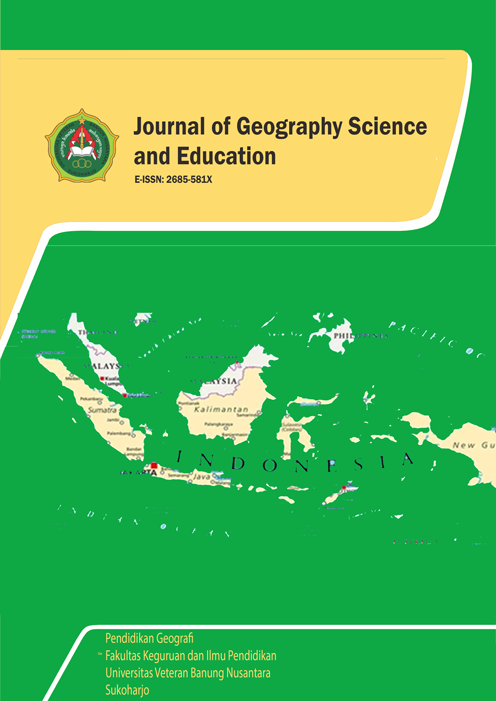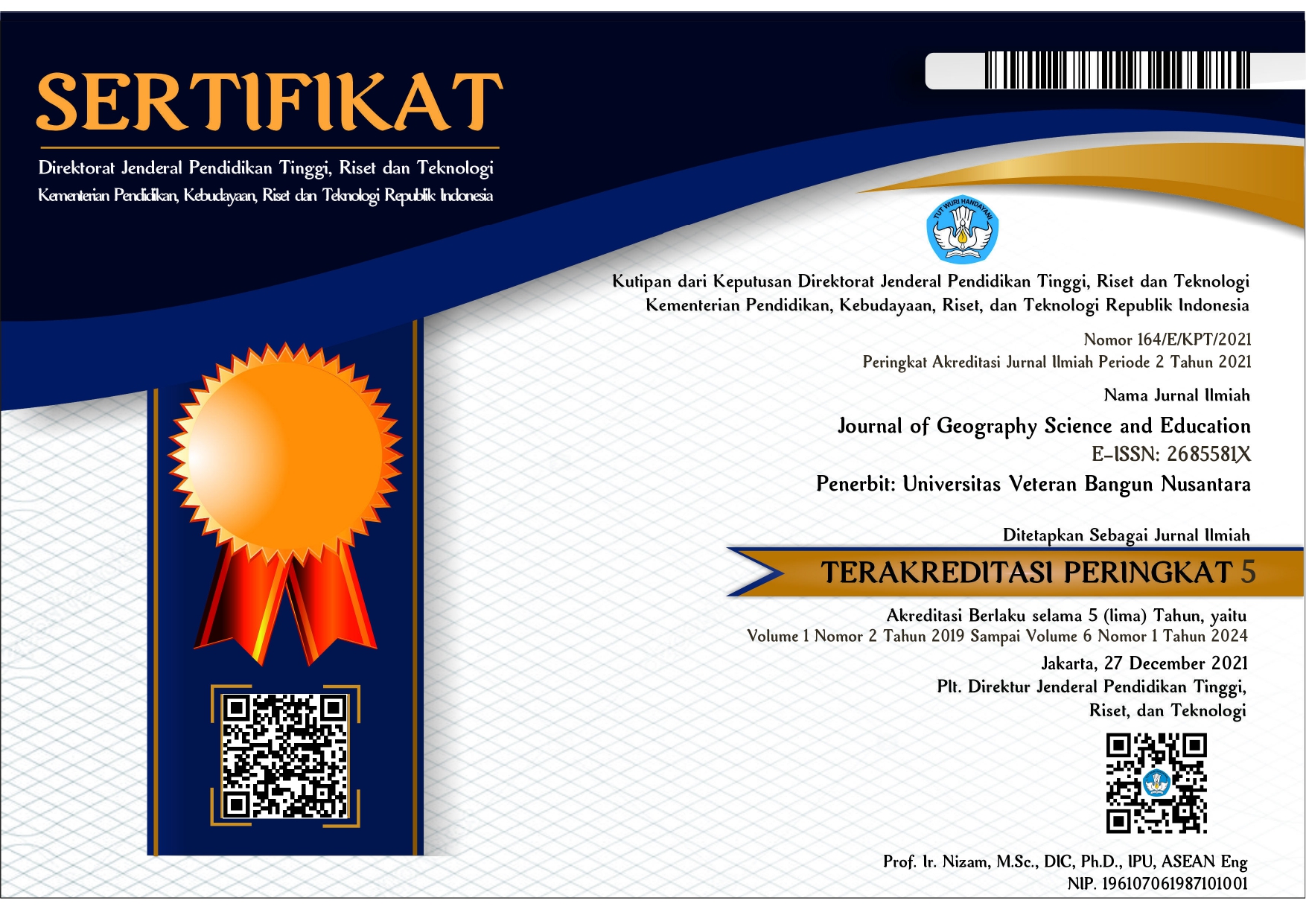Improving the Quality of Learning Through Laboratory Infrastructure facilities at Sma Negeri 1 Polokarto
DOI:
https://doi.org/10.32585/jgse.v3i2.2090Kata Kunci:
Learning, Facilities and Infrastructure, LaboratoryAbstrak
This research aims to improve the quality of learning through laboratory infrastructure facilities at Sma Negeri 1 Polokarto. This research uses a qualitative approach with a type of descriptive approach. The subjects in this study are the heads of biology laboratories, chemical laboratories, physics laboratories, and computer laboratories. Methods of collecting data by means of observation, interview, and documentation. Infrastructure facilities data obtained then compared to the standards that have been determined based on Permendiknas No. 24 of 2007. The results showed that 1.) The laboratory is an important part of the learning process. 2.) Overall the laboratory at Sma Negeri 1 Polokarto has met permendiknas standard No. 24 of 2007. 3.) Chemical and computer laboratory facilities are complete or adequate. 4.) Lack of complete equipment in biology and physics laboratories. 5.) There are several procurement of facilities and infrastructure that are not carried out from the school to the government.Unduhan
Referensi
Anita Christy Simatupang, A. F. (2021). Analisis Sarana dan Prasarana Laboratorium Biologi dan Pelaksanaan Kegiatan Praktikum Biologi Dalam Mendukung Pembelajaran Biologi Kelas XI. Jurnal Pelita Pendidikan, 109-115.
Hayati, A. (2020). Evaluasi StandarSarana dan Prasarana Laboratorium IPA di Sekolah Model SMA Negeri 7 Bengkulu Selatan. Jurnal Manajer Pendidikan, 14, 60- 67.
Hera, R. (2017, Maret). Studi Kasus Pengelolaan Laboratorium SMA Lab School Universitas Syiah Kuala Banda Aceh. Jurnal Bionatural, 4, 34-45.
Maryadi, N. d. (2018, Januari). Manajemen Sarana dan Prasarana Pendidikan dalam Pembelajaran di SD. Jurnal Manajemen Pendidikan, 13, 15 - 23.
Megasari, R. (2014, Juni). Peningkatan Pengelolaan Sarana dan Prasarana Pendidikan Untuk Meningkatkan Kualitas Pembelajaran di SMPN 5 Bukittinggi. Jurnal Adminisreasi Pendidikan , 2, 637 - 831.
Meimuharani, N. I. (n.d.). Pengelolaan Sarana dan Prasarana Pendidikan Untuk Meningkatkan Kualitas Pembelajaran di MAN 4 Aceh Besar.
Mutiara Adilah, A. E. (2021, Februari). Analisis Standarisasi Laboratorium Biologi Sekolah Menengah Atas (SMA) di Kota Pontianak. Jurnal Ilmiah DIDAKTIKA, 21, 195-207.
Sarjono. (2018, Agustus). Pentingnya Laboratorium Fisika di SMA/MA Dalam Menunjang Pembelajaran Fisika. Jurnal Madaniyah, 8, 262-271.
Saryono, B. S. (2016, April). Manajemen Pengelolaan Sarana dan Prasarana Pendidikan Jasmani di SMA Negeri Se Kota Yogyakarta. Jurnal Pendidikan Jasmani Indonesia, 12, 23 - 33.
Yaum, S. (n.d.). Sarana dan Prasarana Administrasi Pendidikan. Retrieved from https://www.academia.edu/21974393/
Hilmiati. (2021). Pemanfaatan Laboratorium Komputer Sebagai Sumber Belajar Pada Pembelajaran Tik (Studi Kasus di SMP N 2 Pagar Alam). Jurnal Ilmiah Teknologi Pendidikan, 216-217.
Unduhan
Diterbitkan
Cara Mengutip
Terbitan
Bagian
Lisensi
License and Copyright Agreement
In submitting the manuscript to the journal, the authors certify that:
- They are authorized by their co-authors to enter into these arrangements.
- The work described has not been formally published before, except in the form of an abstract or as part of a published lecture, review, thesis, or overlay journal. Please also carefully read JGSE's Posting Your Article Policy at http://pubs2.ascee.org/index.php/ijele/about/editorialPolicies#custom-5
- That it is not under consideration for publication elsewhere,
- That its publication has been approved by all the author(s) and by the responsible authorities – tacitly or explicitly – of the institutes where the work has been carried out.
- They secure the right to reproduce any material that has already been published or copyrighted elsewhere.
- They agree to the following license and copyright agreement.
Copyright
Authors who publish with Journal of Geography Science and Education agree to the following terms:
- Authors retain copyright and grant the journal right of first publication with the work simultaneously licensed under a Creative Commons Attribution License (CC BY-SA 4.0) that allows others to share the work with an acknowledgment of the work's authorship and initial publication in this journal.
- Authors are able to enter into separate, additional contractual arrangements for the non-exclusive distribution of the journal's published version of the work (e.g., post it to an institutional repository or publish it in a book), with an acknowledgment of its initial publication in this journal.
- Authors are permitted and encouraged to post their work online (e.g., in institutional repositories or on their website) prior to and during the submission process, as it can lead to productive exchanges, as well as earlier and greater citation of published work.
Licensing for Data Publication
Journal of Geography Science and Education use a variety of waivers and licenses, that are specifically designed for and appropriate for the treatment of data:
- Open Data Commons Attribution License, http://www.opendatacommons.org/licenses/by/1.0/ (default)
- Creative Commons CC-Zero Waiver, http://creativecommons.org/publicdomain/zero/1.0/
- Open Data Commons Public Domain Dedication and Licence, http://www.opendatacommons.org/licenses/pddl/1-0/
Other data publishing licenses may be allowed as exceptions (subject to approval by the editor on a case-by-case basis) and should be justified with a written statement from the author, which will be published with the article.
Open Data and Software Publishing and Sharing
The journal strives to maximize the replicability of the research published in it. Authors are thus required to share all data, code or protocols underlying the research reported in their articles. Exceptions are permitted but have to be justified in a written public statement accompanying the article.
The associated persistent identifiers (e.g. DOI, or others) of the dataset(s) must be included in the data or software resources section of the article. Reference(s) to datasets and software should also be included in the reference list of the article with DOIs (where available). Where no domain-specific data repository exists, authors should deposit their datasets in a general repository such as ZENODO, Dryad, Dataverse, or others.
Small data may also be published as data files or packages supplementary to a research article, however, the authors should prefer in all cases a deposition in data repositories.










